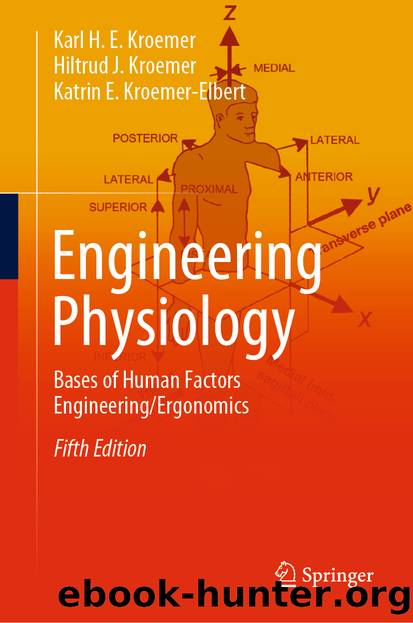Engineering Physiology by Karl H. E. Kroemer & Hiltrud J. Kroemer & Katrin E. Kroemer-Elbert

Author:Karl H. E. Kroemer & Hiltrud J. Kroemer & Katrin E. Kroemer-Elbert
Language: eng
Format: epub
ISBN: 9783030406271
Publisher: Springer International Publishing
As discussed in Chaps. 2 and 3, a signal traveling from a nerve causes a muscle twitch (contraction). A twitch consists of four periods, as described in Table 7.2. The latent period, typically lasting about 10 ms, shows no reaction yet of the muscle fiber to the motor neuron stimulus. Shortening takes place usually within 40 ms for a fast-twitch fiber. Released heat energy causes the cross-bridges between actin and myosin to undergo a thermal vibration, which creates a “ratcheting” action that causes the heads of the actin rods to slide towards each other along the myosin filaments. At the end of this period, the muscle element has reached its shortest length and can developtension. During the relaxation period, also commonly about 40 ms in a fast-twitch fiber, the bridges stop oscillating, the bonds between myosin and actin break, and the muscle is pulled back to its original length either by the action of antagonistic muscle or by an external load. During the recovery period, again taking about 40 ms, the metabolism of the muscle is aerobic, with glucose and stored glycogen being directly oxidized for the final regeneration of ATP and phosphocreatine.Table 7.2Energy metabolism in a single twitch of a fast-twitch fiber
Download
This site does not store any files on its server. We only index and link to content provided by other sites. Please contact the content providers to delete copyright contents if any and email us, we'll remove relevant links or contents immediately.
| Biochemistry | Biomedical Engineering |
| Biotechnology |
Whiskies Galore by Ian Buxton(40294)
Introduction to Aircraft Design (Cambridge Aerospace Series) by John P. Fielding(32329)
Small Unmanned Fixed-wing Aircraft Design by Andrew J. Keane Andras Sobester James P. Scanlan & András Sóbester & James P. Scanlan(32135)
Craft Beer for the Homebrewer by Michael Agnew(17439)
Turbulence by E. J. Noyes(7031)
The Complete Stick Figure Physics Tutorials by Allen Sarah(6631)
Kaplan MCAT General Chemistry Review by Kaplan(6044)
The Thirst by Nesbo Jo(5778)
Bad Blood by John Carreyrou(5761)
Learning SQL by Alan Beaulieu(5399)
Weapons of Math Destruction by Cathy O'Neil(5029)
Man-made Catastrophes and Risk Information Concealment by Dmitry Chernov & Didier Sornette(4728)
iGen by Jean M. Twenge(4693)
Digital Minimalism by Cal Newport;(4510)
Life 3.0: Being Human in the Age of Artificial Intelligence by Tegmark Max(4492)
Audition by Ryu Murakami(4091)
1,001 ASVAB Practice Questions For Dummies by Powers Rod(4034)
Electronic Devices & Circuits by Jacob Millman & Christos C. Halkias(4019)
Pale Blue Dot by Carl Sagan(3995)
